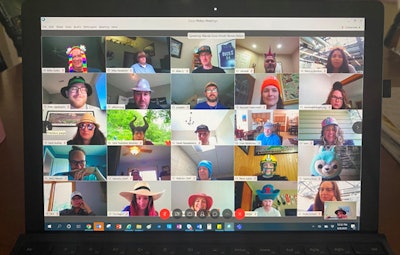
This article was adapted from its original version, "5 Ways Leaders Can Motivate and Inspire Remote Teams” on the AEM website with permission from the author.
The sudden onset of remote work has impacted companies and organizations across the United States and around the world.
It happened almost overnight. The COVID-19 pandemic led some businesses to close their doors and employees to find a way to conduct their work from home. We all went from congregating in meeting spaces and around cubicles to interacting “face to face” via our computer screens. For the past few months, we’ve found ourselves catching glimpses of each other’s homes, hearing dogs barks, and listening to children yell and laugh during video conferences. While we’ve never been farther apart from our colleagues, it’s nice to know it doesn’t always have to feel that way.
Now as the U.S. battles to open back up and some offices consider welcoming back employees into their facilities, we know some members of the workforce will continue to remain remote for the time being. With that fact in mind, AEM wanted to share five useful and common-sense ways in which business leaders can motivate remote teams and help them keep pace with organizational demands and goals.
1. Check in frequently
Whether it comes in the form of asking a quick question, clarifying a detail, or soliciting feedback on an idea, find a reason to reach out to your team members. Not all that long ago, it was so easy to simply swing by a colleague’s workstation and have a quick conversation. Now, with so many people working remotely, doing so requires being more intentional. And while technology certainly helps to facilitate communication while working remotely, it’s only useful if you’re willing to set aside a few minutes for video chat “face time” with one or more of your teammates.
While it can be easy to feel like you may be intruding or imposing on others, you’re really not. And, by checking in more frequently, you’ll eventually become more comfortable and convey a message that regular interactions should continue to take place.
2. Have fun!
Making an effort to socialize and have fun with your team is critically important to establishing stronger inter-office relationships. For example, my team and I get together on video chat every other week over the lunch break for about 30-45 minutes. We catch up with one another, take a break from our work, and talk about a favorite book we’ve read or a movie we’ve recently seen.
Ultimately, engaging your teammates and facilitating a bit of fun helps promote a sense of belonging and community – something that’s incredibly important during these uncertain times.
In addition, AEM held an all-staff online meeting were we asked everyone to wear a crazy hat and we randomly selected individuals to share their favorite quarantine memory. This 30-minute meeting exclusively focused on fun and sharing personal stories. It was a great way to connect on a personal level without having any business on the agenda, and feedback has been very positive.
3. Be flexible and human
The “traditional” workday is traditional no more, and flexibility is everything these days. As a leader, you need to know that your team members have a lot going on in their lives right now. Some may not be able to work the typical 8 a.m.-4 p.m. or 9 a.m.-5 p.m. schedule, and they need to know they can stop and address certain situations as they arise at home.
Few things will motivate your team members more than having a flexible boss who trusts them to manage their days effectively. Let them take care of their personal business, as they will likely go out of their way to re-engage later in the evening or early the next morning.
4. Reinforce the value of team roles
With how everything has unfolded over the course of the past few months, it’s no secret that priorities within organizations are constantly changing with time. Organizational pivots are stressful experiences, and they can cause quite a bit of anxiety and uncertainty among employees.
If you’re a leader, one of your top priorities right now should be maintaining communications with the members of your team. Let them know if their roles are changing, and be sure to convey how their positions fit into the organization’s “bigger picture.” They’ll appreciate the fact that they are continuing to add value, even if that comes in a different form than it did in the past.
5. Provide opportunities for leadership
There’s no better time than right now to encourage your team members to step up, expand their skill sets, and take advantage of available training opportunities. Let your employees be leaders and allow them to come forward and let you know how they want to get involved.
As an established leader, you need to be flexible. Lead with empathy and understanding, and be sure to set your employees up to be motivated and productive by ensuring they have the support, tools, and resources they need to become leaders themselves and – ultimately – bring greater value to your organization.



















